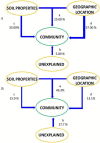Bacterial community and arsenic functional genes diversity in arsenic contaminated soils from different geographic locations
- PMID: 28475654
- PMCID: PMC5419559
- DOI: 10.1371/journal.pone.0176696
Bacterial community and arsenic functional genes diversity in arsenic contaminated soils from different geographic locations
Erratum in
-
Correction: Bacterial community and arsenic functional genes diversity in arsenic contaminated soils from different geographic locations.PLoS One. 2017 Dec 7;12(12):e0189656. doi: 10.1371/journal.pone.0189656. eCollection 2017. PLoS One. 2017. PMID: 29216322 Free PMC article.
Abstract
To understand how soil microbial communities and arsenic (As) functional genes respond to soil arsenic (As) contamination, five soils contaminated with As at different levels were collected from diverse geographic locations, incubated for 54 days under flooded conditions, and examined by both MiSeq sequencing of 16S rRNA gene amplicons and functional gene microarray (GeoChip 4.0). The results showed that both bacterial community structure and As functional gene structure differed among geographical locations. The diversity of As functional genes correlated positively with the diversity of 16S rRNA genes (P< 0.05). Higher diversities of As functional genes and 16S rRNA genes were observed in the soils with higher available As. Soil pH, phosphate-extractable As, and amorphous Fe content were the most important factors in shaping the bacterial community structure and As transformation functional genes. Geographic location was also important in controlling both the bacterial community and As transformation functional potential. These findings provide insights into the variation of As transformation functional genes in soils contaminated with different levels of As at different geographic locations, and the impact of environmental As contamination on the soil bacterial community.
Conflict of interest statement
Figures





Similar articles
-
Temporal dynamics of total and free-living nitrogen-fixing bacterial community abundance and structure in soil with and without history of arsenic contamination during a rice growing season.Environ Sci Pollut Res Int. 2018 Feb;25(5):4951-4962. doi: 10.1007/s11356-017-0858-5. Epub 2017 Dec 5. Environ Sci Pollut Res Int. 2018. PMID: 29204941
-
Arsenic methylation in soils and its relationship with microbial arsM abundance and diversity, and as speciation in rice.Environ Sci Technol. 2013 Jul 2;47(13):7147-54. doi: 10.1021/es304977m. Epub 2013 Jun 21. Environ Sci Technol. 2013. PMID: 23750559
-
Depth-resolved microbial community analyses in two contrasting soil cores contaminated by antimony and arsenic.Environ Pollut. 2017 Feb;221:244-255. doi: 10.1016/j.envpol.2016.11.071. Epub 2016 Dec 12. Environ Pollut. 2017. PMID: 27979681
-
Municipal solid wastes as a resource for environmental recovery: Impact of water treatment residuals and compost on the microbial and biochemical features of As and trace metal-polluted soils.Ecotoxicol Environ Saf. 2019 Jun 15;174:445-454. doi: 10.1016/j.ecoenv.2019.03.007. Epub 2019 Mar 7. Ecotoxicol Environ Saf. 2019. PMID: 30852309
-
Microbial diversity and function in soil: from genes to ecosystems.Curr Opin Microbiol. 2002 Jun;5(3):240-5. doi: 10.1016/s1369-5274(02)00324-7. Curr Opin Microbiol. 2002. PMID: 12057676 Review.
Cited by
-
Diversity of Betaproteobacteria revealed by novel primers suggests their role in arsenic cycling.Heliyon. 2020 Jan 2;6(1):e03089. doi: 10.1016/j.heliyon.2019.e03089. eCollection 2020 Jan. Heliyon. 2020. PMID: 31922045 Free PMC article.
-
Characterization of the rare microbiome of rice paddy soil from arsenic contaminated hotspot of West Bengal and their interrelation with arsenic and other geochemical parameters.World J Microbiol Biotechnol. 2022 Jul 30;38(10):171. doi: 10.1007/s11274-022-03355-9. World J Microbiol Biotechnol. 2022. PMID: 35907093
-
Metagenomic and culture-dependent approaches unveil active microbial community and novel functional genes involved in arsenic mobilization and detoxification in groundwater.BMC Microbiol. 2023 Aug 30;23(1):241. doi: 10.1186/s12866-023-02980-0. BMC Microbiol. 2023. PMID: 37648982 Free PMC article.
-
Identification of Arsenic Resistance Genes from Marine Sediment Metagenome.Indian J Microbiol. 2017 Sep;57(3):299-306. doi: 10.1007/s12088-017-0658-0. Epub 2017 Jul 5. Indian J Microbiol. 2017. PMID: 28904414 Free PMC article.
-
Impacts of Arsenic and Antimony Co-Contamination on Sedimentary Microbial Communities in Rivers with Different Pollution Gradients.Microb Ecol. 2019 Oct;78(3):589-602. doi: 10.1007/s00248-019-01327-5. Epub 2019 Feb 6. Microb Ecol. 2019. PMID: 30725170
References
-
- Brammer H. Ravenscroft P. Arsenic in groundwater: a threat to sustainable agriculture in South and South-east Asia. Environ Inter. 2009; 35: 647–654. - PubMed
-
- Meharg AA, Williams PN, Adomako E, Lawgali YY, Deacon C, Villada A, et al. Geographical variation in total and inorganic arsenic content of polished (white) rice. Environ Sci Technol. 2009; 43: 1612–1617. - PubMed
MeSH terms
Substances
LinkOut - more resources
Full Text Sources
Other Literature Sources
Medical
Molecular Biology Databases
Research Materials

